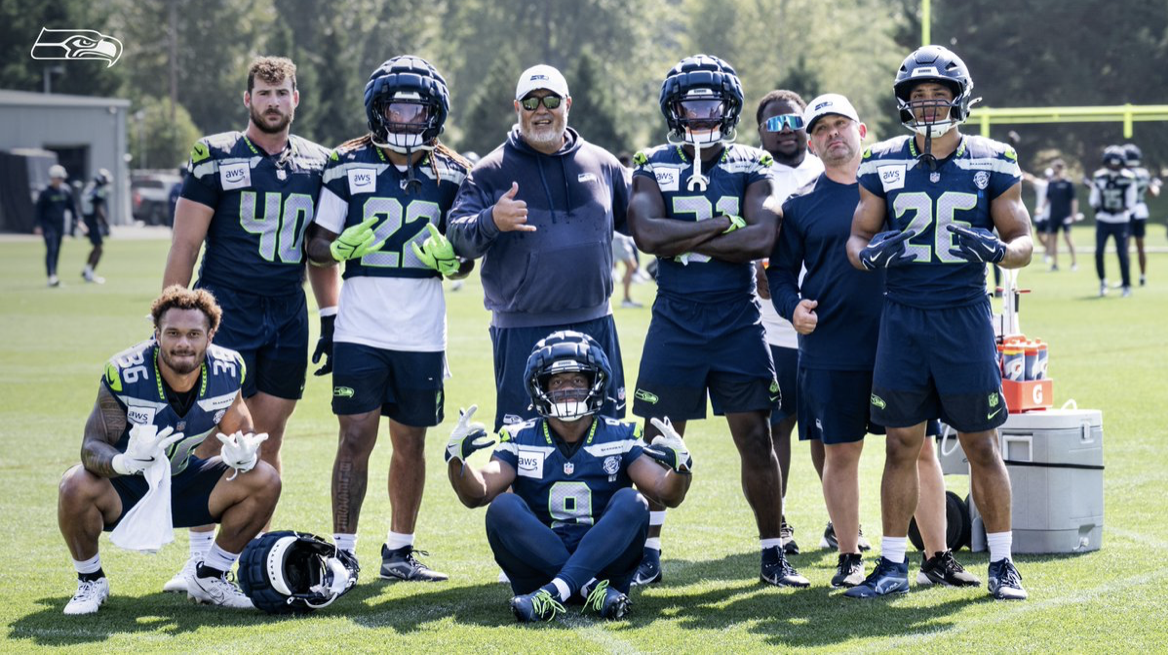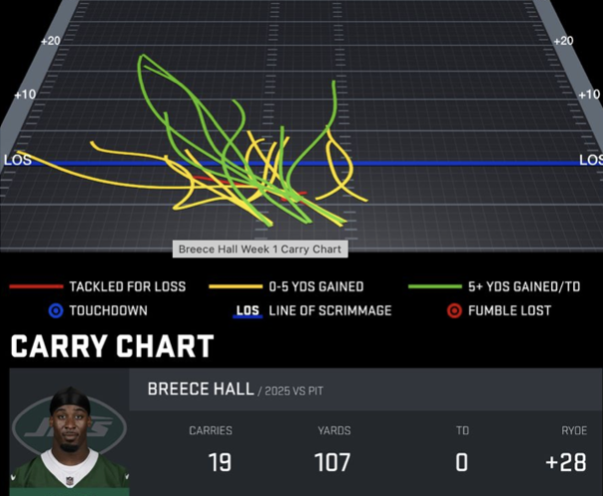This is a guest post by Curtis Allen…
A bitterly tough and confusing loss is almost in the rearview mirror.
After last week’s game, questions about the team’s offseason and game planning rang out loudly.
Will the offense be committed to running the ball? Is Kenneth Walker healthy enough to be the difference-maker we know he can be? How do the Seahawks feature him and Zach Charbonnet in the offense? Was the lack of Tight End usage an aberration, or is the unit not yet ready to contribute?
On defense, can Riq Woolen overcome his lapses in coverage and return to his rookie season form in a contract year? Can Byron Murphy do more than be a good run stopper inside? What kind of exotic looks can Mike Macdonald cook up with all the young talent he has on defense?
Questions like these may linger throughout the entire season if not addressed quickly.
The NFL season is a discovery process. Fans cannot see behind the curtain to really know what their team is cooking up. Even the team cannot completely know how their plans will work out. It can only be seen on the field of play.
Week Two provides a major opportunity to discover further answers to the questions we have. The Seahawks travel to Pittsburgh to face a star-studded but flawed Steelers team. They match up well with the Steelers and their stated team philosophy of running and playing tough defense is a key to success on the road.
But can they bounce back from a Week One loss and get right?
That’s what we will have to discover.
Play the Game You Designed Your Team to Play
The Steelers defense shines with star power – TJ Watt is one of the league’s best, Alex Highsmith is one of the league’s most underrated, Patrick Queen was a Pro Bowl player last year and Jalen Ramsey demonstrated Sunday that he still has juice as a versatile and tough defender.
That said, this defense has been vulnerable in two critical areas: Defending the traditional run (especially the zone run game), the Quarterback scramble and defending Tight Ends in the passing game.
Last week they gave up five (!) explosive runs to the Jets on their way to conceding 182 yards on the ground. The Jets gained 13 first downs and scored three touchdowns on the ground.
Though the Steelers are known for tough defense they are extremely vulnerable in the zone run game, as pointed out here (hat tip to commenter KH for finding this gem):
Here’s how schematic matchups can help find good DFS plays which are also low-owned
PIT D allowed 5th fewest yards/rush (4.05) BUT
vs ZONE rush: 31st, 4.98/rush, 52.3 success rate
vs MAN/GAP: 2nd, 2.84/rush, 39.2 SRMIN D too
Zone-heavy running games were great plays vs both pic.twitter.com/08RE0akgqG
— Matt Butler (@ButlerinAustin) September 6, 2025
The Seahawks need to primarily run their zone running scheme with some gap running sprinkled in to keep things off-kilter. This is what they wanted and Klint Kubiak was so good at: find ways to manage the game and take pressure off the Offensive Line in the passing game.
Simply put, they need to commit to the run game.
How did the Jets run so effectively? They ran as far away from T.J. Watt as they possibly could:
Just look at that run chart. It is lopsided towards the Left Side of the field. T.J. Watt spends most of his time lined up over the Right Tackle. The Jets even took precautions to have a Running Back lead block Watt at times so he could not crash the play from the back side. A perfect job for Robbie Ouzts at times, no?
The Seahawks will not and should not run the exact same play package as the Jets. But there is a lot of wisdom in it and the Steelers did not have an answer for it.
One thing they can exploit that the Jets did not – run right at Watt. They need to be very selective and have good timing. But a play where Abe Lucas allows Watt to rush himself out of the edge and let the Running Back exploit that hole can do wonders for the offense. Getting a good run and making Watt hesitate just a little is worth the occasional gamble.
Another strength the Seahawks have yet to properly exploit is with the Quarterback. Justin Fields scrambled and used his legs to move up in the pocket and then rush when he had openings. Nobody is ever going to confuse Sam Darnold with Fields but this is an area where the Steelers have had a disconnect between their powerful rush ends and the second level of the defense. Fields burned them consistently for yards on the ground and Darnold (with his quick decision-making) should not hesitate to take off at any time he sees a proper opening.
Another way to attack this defense was not heavily exploited by the Jets last week but should be by the Seahawks: regular throwing to the Tight Ends as part of the offense.
Last year, the Steelers were one of the NFL’s worst at defending Tight Ends in the passing game. Opponents averaged about six catches and 70 yards per game.
And while Patrick Queen earned a trip to the Pro Bowl, he was not good in pass coverage (PFF grade in the 50’s last year and 52.3 in Week One) and opponents know it: Queen was the second-most targeted defender for the Steelers last year and one of the most frequently targeted Linebackers in the NFL. He gave up 9.7 yards per reception in coverage and 6.5 yards after the catch.
Regularly sending Tight Ends into routes also keeps Queen moving backwards rather than patrolling the area behind the line of scrimmage, where he is best. That helps make the running game effective as well.
The Steelers are also badly banged up in their secondary, with Jabril Peppers signed off the street this week to fill in for DeShone Elliot. Quick seam routes and in-breaking slants should be regular features of the offensive attack.
Once some effectiveness is established there, the play-action can become a tool to keep pass rushers and linebackers hesitating and the field should open up for the Wide Receivers.
All of this works together. The Seahawks should be able to move the ball on this defense if they practice what they preach: good fundamentals, tough play and keeping your overall goals and strengths at the forefront of your plan.
Keep the Game in Front of Them on Defense
The Steelers have placed an extraordinary amount of their hopes and dreams for the 2025 season on Aaron Rodgers’ shoulders. It was a drama that played out all offseason in a way that only Rodgers can get away with.
What does that mean for the team and for this game in particular?
With an offensive line that is young and still finding their way, and a running game that so far has not produced a lot, they need Rodgers to throw. A lot. That means designing an offense to keep the 42-year-old upright.
Over the years, Rodgers-quarterbacked teams have slowly shortened his passing depths in each season. It helps him get the ball out quickly and avoid being sacked or hit as much.
In his prime, Rodgers’ Intended Air Yards per Pass Attempt was in the 8-8.8 yard range, right about the middle of the NFL. Mike LaFleur in Green Bay started slowly pulling that back a bit. And now that Rodgers is older and has sustained a serious knee injury in the recent past, it went down to 6.8 yards last year in New York.
This year in Week One? 4.6 yards per attempt, one of the lowest in the NFL. That means the bulk of his passing yards are coming from Yards after the Catch.
Metcalf is only four yards downfield when he catches the ball but gains 23 total yards and a first down.
The four-yard catch is fine. What he does after the catch is not.
The Seahawks need to think horizontally on defense. Julian Love and Coby Bryant can handle the deep middle of the field. Linebackers and Corners need to think primarily about the first five yards of the field, and keep receivers in front of them. If they do not allow a regular movement of the offense to result in these 20-yard explosive plays, the odds swing in their favor and the chances the Steelers can put three downs together to gain ten yards go down.
If they can mix in the occasional tight press type coverage to get Rodgers off his quick timing, that will keep this offense off-balance and allow rushers like Boye Mafe and Derick Hall to pin their ears back and get after Rodgers.
Broderick Jones was dreadful in his first game at Left Tackle and Troy Fautanu played like a rookie in his first NFL game at Right Tackle. This could be a real problem for the Steelers offense.



